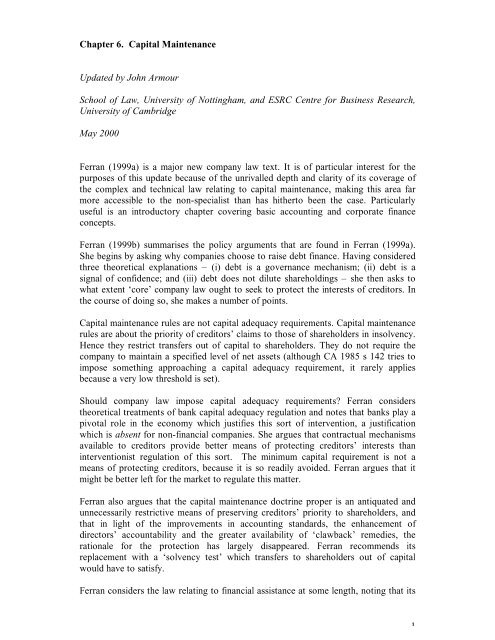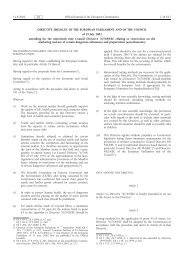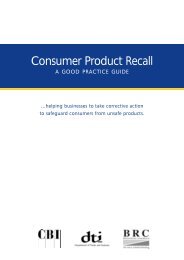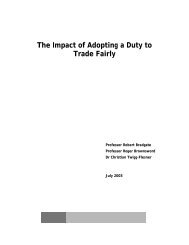1 Chapter 6. Capital Maintenance Updated by John Armour School ...
1 Chapter 6. Capital Maintenance Updated by John Armour School ...
1 Chapter 6. Capital Maintenance Updated by John Armour School ...
Create successful ePaper yourself
Turn your PDF publications into a flip-book with our unique Google optimized e-Paper software.
<strong>Chapter</strong> <strong>6.</strong> <strong>Capital</strong> <strong>Maintenance</strong><br />
<strong>Updated</strong> <strong>by</strong> <strong>John</strong> <strong>Armour</strong><br />
<strong>School</strong> of Law, University of Nottingham, and ESRC Centre for Business Research,<br />
University of Cambridge<br />
May 2000<br />
Ferran (1999a) is a major new company law text. It is of particular interest for the<br />
purposes of this update because of the unrivalled depth and clarity of its coverage of<br />
the complex and technical law relating to capital maintenance, making this area far<br />
more accessible to the non-specialist than has hitherto been the case. Particularly<br />
useful is an introductory chapter covering basic accounting and corporate finance<br />
concepts.<br />
Ferran (1999b) summarises the policy arguments that are found in Ferran (1999a).<br />
She begins <strong>by</strong> asking why companies choose to raise debt finance. Having considered<br />
three theoretical explanations – (i) debt is a governance mechanism; (ii) debt is a<br />
signal of confidence; and (iii) debt does not dilute shareholdings – she then asks to<br />
what extent ‘core’ company law ought to seek to protect the interests of creditors. In<br />
the course of doing so, she makes a number of points.<br />
<strong>Capital</strong> maintenance rules are not capital adequacy requirements. <strong>Capital</strong> maintenance<br />
rules are about the priority of creditors’ claims to those of shareholders in insolvency.<br />
Hence they restrict transfers out of capital to shareholders. They do not require the<br />
company to maintain a specified level of net assets (although CA 1985 s 142 tries to<br />
impose something approaching a capital adequacy requirement, it rarely applies<br />
because a very low threshold is set).<br />
Should company law impose capital adequacy requirements? Ferran considers<br />
theoretical treatments of bank capital adequacy regulation and notes that banks play a<br />
pivotal role in the economy which justifies this sort of intervention, a justification<br />
which is absent for non-financial companies. She argues that contractual mechanisms<br />
available to creditors provide better means of protecting creditors’ interests than<br />
interventionist regulation of this sort. The minimum capital requirement is not a<br />
means of protecting creditors, because it is so readily avoided. Ferran argues that it<br />
might be better left for the market to regulate this matter.<br />
Ferran also argues that the capital maintenance doctrine proper is an antiquated and<br />
unnecessarily restrictive means of preserving creditors’ priority to shareholders, and<br />
that in light of the improvements in accounting standards, the enhancement of<br />
directors’ accountability and the greater availability of ‘clawback’ remedies, the<br />
rationale for the protection has largely disappeared. Ferran recommends its<br />
replacement with a ‘solvency test’ which transfers to shareholders out of capital<br />
would have to satisfy.<br />
Ferran considers the law relating to financial assistance at some length, noting that its<br />
1
ambit is broader than is necessary to implement the capital maintenance principle. She<br />
considers and rejects three possible rationales for the rules: (i) the prevention of<br />
market manipulation; (ii) the prevention of ‘share support’ schemes in relation to<br />
takeovers, and (iii) the protection of creditors. She suggests that, in the light of other,<br />
more clearly targeted regulatory measures and creditors’ greater sophistication, the<br />
extensive financial assistance rules are no longer required. She suggests that creditors<br />
could be adequately protected through the introduction of a ‘solvency’ requirement, as<br />
for the capital maintenance rules.<br />
Ferran acknowledges the restrictive effect of the Second Company Law Directive, but<br />
suggests that this should not be allowed to inhibit reform (i) in respect of private<br />
companies, at all ; (ii) in respect of public companies, any further than is necessary to<br />
achieve minimum compliance with the Directive.<br />
<strong>Armour</strong> (2000) notes that the promotion of ‘efficiency’ is central to the aims of the<br />
Company Law Review’s Strategic Framework document, and asks whether the body<br />
of rules known as ‘capital maintenance’ are likely to be an appropriate means of doing<br />
this. He suggests that whilst the current rules are unlikely, on the whole, to be justified<br />
in terms of efficiency, a case may be made for a framework within which companies<br />
may ‘opt in’ to customised restrictions on dealings in their share capital.<br />
The paper suggests that the ‘presumption against prescription’ set out in the Strategic<br />
Framework implies that a case for legal intervention on the grounds of enhancing<br />
efficiency must be made out on the grounds that a market subject to a given legal rule<br />
will function in a more efficient manner than one without such a rule.<br />
The analysis of the law is conducted in three stages. The first considers possible<br />
rationales for legal intervention. The second asks whether any of these might in theory<br />
underpin the rules of capital maintenance. Third, the author asks whether the rules are<br />
likely to be successful in enhancing efficiency— ie that the benefits they confer<br />
through remedying market imperfections will outweigh any attendant costs that they<br />
generate for parties.<br />
The rules regulating the raising of capital (the par value rule, and the ‘expert<br />
valuation’ rules for public companies) might be understood as responding to<br />
information asymmetries in markets for corporate credit, <strong>by</strong> making it more likely that<br />
capital figures stated in firms’ public documents will actually have been represented<br />
<strong>by</strong> assets paid into the company <strong>by</strong> shareholders. In practice, however, this<br />
information is unlikely to be of relevance to creditors, and the costs of compliance<br />
with the rules therefore almost certainly outweigh any benefits they confer.<br />
The rules mandating public companies to be formed with a minimum capital, when<br />
viewed in conjunction with the ‘expert valuation’ rules, and CA 1985 s 142, might be<br />
understood as a primitive means of protecting ‘involuntary’ creditors from the use of<br />
limited liability companies as an easy ‘judgment-proofing’ strategy for those<br />
conducting hazardous activities. However, this is at once likely to be both under and<br />
over-inclusive. The more useful the measure as a means of preventing judgmentproofing<br />
(ie the higher it is set) the more restrictive it will be on firms’ ability to make<br />
use of limited liability. If this were the only technique available for internalising the<br />
costs which judgement-proofing may impose on involuntary creditors, then we would<br />
2
have cause for a detailed enquiry into costs and benefits. However, there are a variety<br />
of more finely-tuned regulatory techniques which might be adopted instead— such as<br />
unlimited shareholder liability, superpriority for involuntary creditors, and mandatory<br />
insurance regimes.<br />
<strong>Armour</strong> argues that the capital maintenance rules can be understood as supplying<br />
‘terms’ into bargains between creditors and shareholders. Empirical studies show that<br />
creditors and firms do in fact spend resources drafting loan covenants which restrict<br />
companies’ distributions to shareholders. In the US, where distributions rules no<br />
longer have any teeth, some studies suggest that such covenants take a form which<br />
bears a striking resemblance to the restriction found in the Companies Act 1985. Thus<br />
the case for the legal protection of creditors should not be dismissed out of hand.<br />
However, the capital maintenance rules also generate costs, particularly in small<br />
firms, where shareholders are unable to withdraw capital from the firm when it has no<br />
good projects to pursue. There is some evidence that this may actually encourage<br />
undercapitalisation in small firms. Even so, if the current rules were the only possible<br />
regulatory solution, we would have cause for more detailed investigation of the costs<br />
and benefits.<br />
<strong>Armour</strong> suggests, however, that a superior alternative exists in the form of default<br />
rules restricting distributions. Because one term is unlikely to suit all parties’ needs,<br />
these could be offered in the form of a ‘menu’ into which firms could opt in on<br />
incorporation, and could perhaps subsequently switch through a collective creditor<br />
decision-making mechanism.<br />
Financial assistance can be seen as combating the unusually severe conflicts of<br />
interest which arise in the case of leveraged buy-outs (LBOs). Where a firm is<br />
purchased <strong>by</strong> a heavily-indebted buyer, and the former’s assets are used to underwrite<br />
the latter’s loan, then ‘old’ creditors of the firm will experience a sudden and dramatic<br />
increase in the riskiness of their debt. The American experience proves instructive<br />
once more, where there are no financial assistance laws, but there have been calls for<br />
mandatory rules designed to protect creditors from precisely this sort of risk. <strong>Armour</strong><br />
again suggests, however, that the case for mandatory rules is probably not made out.<br />
Whilst they might (perhaps) be better than no rules, default rules (in the form of an<br />
opt-in menu) would clearly be superior to both.<br />
The author concludes with a call for serious consideration to be given to his proposal<br />
for a ‘menu’ of creditor terms to be made available <strong>by</strong> the law to firms and their<br />
creditors.<br />
Bibliography<br />
<strong>Armour</strong>, J. (2000) ‘Share capital and creditor protection: efficient rules for a modern<br />
company law’ Modern Law Review, 63: 355-378.<br />
Ferran, E. (1999a) Company Law and Corporate Finance Oxford: Oxford University<br />
Press.<br />
Ferran, E. (1999b) ‘Creditors’ interests and “core” company law’, Company Lawyer,<br />
3
20: 314-323.<br />
4
















